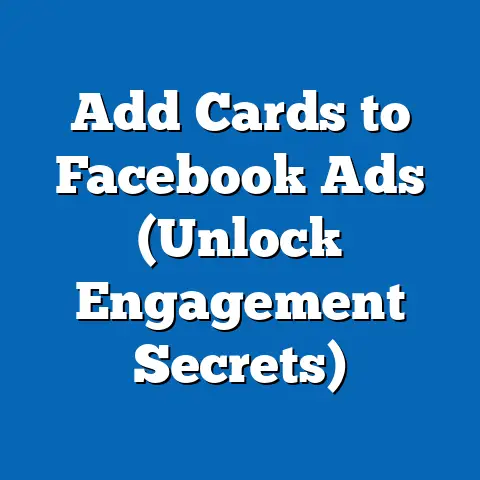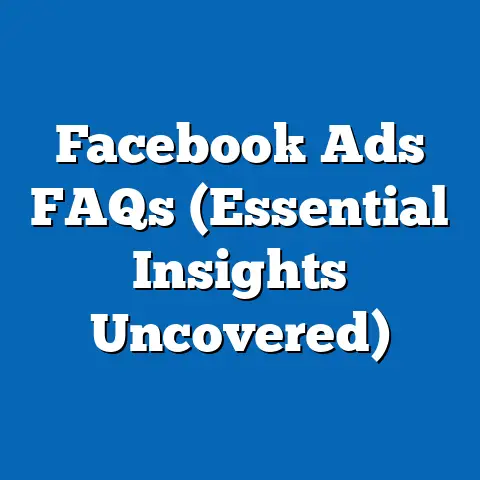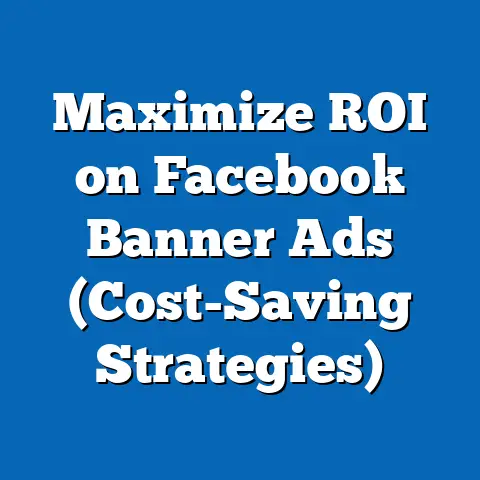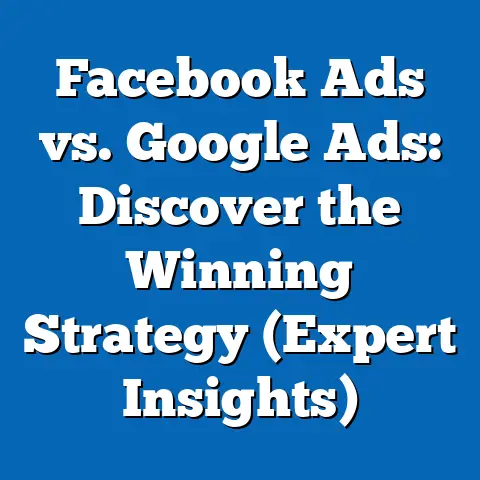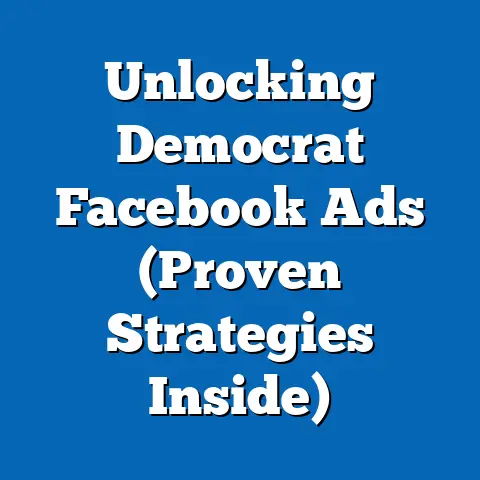Maximize Reach in Facebook Ads (Expert Strategies)
Maximize Reach in Facebook Ads: Expert Strategies
The digital marketing landscape is a constantly shifting terrain. What worked yesterday might not work today. That’s especially true on platforms like Facebook, where algorithm updates, user behavior shifts, and new advertising features are the norm, not the exception. Businesses that want to succeed with Facebook Ads need to be agile, adaptable, and committed to continuous learning. I’ve seen countless businesses stumble, not because they lacked a great product or service, but because they failed to adapt their Facebook Ads strategy to the platform’s dynamic nature. This article is your guide to navigating that terrain and maximizing your reach, not just in terms of impressions, but in terms of meaningful engagement with your target audience. Let’s get started!
Understanding Facebook’s Algorithm
The Facebook algorithm, often referred to as “the algorithm,” is the backbone of what users see in their news feeds. It’s a complex system that decides which content is displayed to whom, and in what order. For advertisers, understanding this algorithm is crucial because it directly impacts the visibility of your ads.
The algorithm considers a multitude of factors, including:
- Engagement: Posts and ads that receive high engagement (likes, comments, shares, saves) are favored. Facebook interprets engagement as a sign that the content is relevant and interesting to users. I’ve personally seen ads with high engagement rates get significantly more reach, even with the same budget, compared to ads with low engagement.
- Relevance Score: This metric (now less prominent but still influential) estimates how relevant your ad is to your target audience. A higher relevance score can lead to lower costs and better ad delivery.
- Bidding Strategy: The bidding strategy you choose influences how Facebook delivers your ads. For example, a “lowest cost” bid strategy might prioritize cost-efficiency over reach, while a “highest value” bid strategy might prioritize reaching the most valuable users, even at a higher cost.
- Ad Quality: Facebook evaluates the quality of your ad based on factors like clarity, accuracy, and user experience. Ads that are deemed low-quality or misleading are penalized.
- Post Frequency: Bombarding users with too many ads from the same source can lead to ad fatigue and decreased engagement. Facebook’s algorithm can penalize accounts that exhibit this behavior.
- User Signals: The algorithm learns from user behavior. If users frequently hide or report your ads, your reach will likely suffer.
Audience Segmentation and Targeting:
Effective audience segmentation is essential for maximizing reach. Facebook offers a wide array of targeting options, allowing you to narrow down your audience based on demographics, interests, behaviors, and more. By understanding your audience and tailoring your ads to their specific needs and preferences, you can increase relevance and engagement, which in turn boosts your ad’s visibility.
Key Takeaway:
The Facebook algorithm is a complex system that rewards relevant, engaging content. By understanding how the algorithm works and optimizing your ads accordingly, you can significantly increase your reach. Focus on creating high-quality ads that resonate with your target audience and avoid practices that could be penalized by the algorithm.
Crafting Compelling Ad Creative
Ad creative is the face of your Facebook ad campaign. It’s what grabs users’ attention and convinces them to take action. Even with the best targeting in the world, mediocre creative will lead to lackluster results. I’ve seen firsthand how a simple change in an ad’s image or headline can dramatically impact its performance.
Here are the key elements of compelling ad creative:
- Eye-Catching Visuals: Use high-quality images or videos that are relevant to your product or service and visually appealing to your target audience. Consider using vibrant colors, interesting compositions, and images that evoke emotion.
- Persuasive Copy: Your ad copy should be clear, concise, and persuasive. Highlight the benefits of your product or service and address the needs and pain points of your target audience. Use strong verbs and compelling language to encourage action.
- Strong Calls-to-Action (CTAs): Every ad should have a clear and compelling CTA that tells users what you want them to do. Use action-oriented language and make your CTA button visually prominent. Examples include “Shop Now,” “Learn More,” “Sign Up,” or “Get a Quote.”
- Relevance: Your ad creative should be highly relevant to your target audience and the context in which they’re seeing the ad. Tailor your messaging and visuals to resonate with their specific interests and needs.
- Branding: Maintain a consistent brand identity across all of your ads. Use your brand colors, fonts, and logo to create a cohesive and recognizable brand experience.
A/B Testing:
A/B testing, also known as split testing, is the process of comparing two versions of an ad to see which performs better. By A/B testing different creatives, you can identify what resonates most with your target audience and optimize your ads for maximum reach and engagement. I always tell my clients, “Don’t assume you know what works. Test it!”
Here are some elements you can A/B test:
- Headlines: Test different headlines to see which ones grab the most attention and generate the most clicks.
- Images/Videos: Experiment with different visuals to see which ones resonate most with your target audience.
- Ad Copy: Test different versions of your ad copy to see which ones are most persuasive.
- CTAs: Try different CTAs to see which ones drive the most conversions.
Examples of Successful Ad Campaigns:
- Dollar Shave Club: Dollar Shave Club’s viral video ads are a prime example of innovative creative strategies. Their humorous and relatable approach resonated with their target audience and helped them expand their reach significantly.
- Airbnb: Airbnb often uses user-generated content (UGC) in their ads, showcasing real people’s experiences with their platform. This authentic approach builds trust and encourages others to book accommodations through Airbnb.
- Nike: Nike’s ads often feature inspirational stories and messages that resonate with athletes and fitness enthusiasts. Their focus on empowerment and motivation helps them connect with their target audience on a deeper level.
Key Takeaway:
Compelling ad creative is essential for maximizing reach on Facebook. By using eye-catching visuals, persuasive copy, strong CTAs, and relevant messaging, you can grab users’ attention and encourage them to take action. Don’t be afraid to experiment with different creatives and use A/B testing to identify what works best for your target audience.
Leveraging Audience Insights and Targeting
Facebook Audience Insights is a powerful tool that provides valuable data about your target audience. It allows you to gain a deeper understanding of their demographics, interests, behaviors, and more. This information is crucial for refining your targeting and creating ads that resonate with your audience. I’ve seen campaigns transformed simply by using Audience Insights to understand the nuances of the target demographic.
Here’s how to leverage Audience Insights for maximum reach:
- Demographics: Understand the age, gender, education level, and relationship status of your target audience. This information can help you tailor your messaging and visuals to resonate with their specific characteristics.
- Interests: Identify the interests and hobbies of your target audience. This information can help you target your ads to users who are likely to be interested in your product or service.
- Behaviors: Understand the online behaviors of your target audience, such as their purchase history, device usage, and travel habits. This information can help you target your ads to users who are likely to take specific actions.
- Page Likes: See which pages your target audience likes on Facebook. This information can help you identify their interests and preferences and target your ads accordingly.
- Location: Understand where your target audience is located. This information can help you tailor your ads to local markets and languages.
Targeting Options:
Facebook offers a wide range of targeting options, allowing you to narrow down your audience based on a variety of factors:
- Custom Audiences: Create custom audiences based on your existing customer data, such as email addresses, phone numbers, or website visitors. This allows you to target your ads to users who are already familiar with your brand.
- Lookalike Audiences: Create lookalike audiences based on your custom audiences. This allows you to target your ads to users who share similar characteristics with your existing customers.
- Detailed Targeting: Use detailed targeting to target your ads based on demographics, interests, behaviors, and more. This allows you to create highly specific audiences that are likely to be interested in your product or service.
Segmentation Strategies:
- Demographic Segmentation: Segment your audience based on age, gender, location, education level, and other demographic factors.
- Interest-Based Segmentation: Segment your audience based on their interests and hobbies.
- Behavioral Segmentation: Segment your audience based on their online behaviors, such as purchase history or device usage.
- Value-Based Segmentation: Segment your audience based on their potential value to your business.
Key Takeaway:
Leveraging Audience Insights and refining your targeting are essential for maximizing reach on Facebook. By understanding your audience and tailoring your ads to their specific needs and preferences, you can increase relevance and engagement, which in turn boosts your ad’s visibility. Don’t underestimate the power of data!
Utilizing Ad Formats and Placements
Facebook offers a variety of ad formats and placements, each with its own unique strengths and weaknesses. Choosing the right formats and placements can significantly impact your ad’s reach and engagement. I’ve learned that understanding the nuances of each format and where it performs best is critical to a successful campaign.
Ad Formats:
- Single Image Ads: These are the simplest ad format, featuring a single image and accompanying text. They are effective for showcasing a product or service in a visually appealing way.
- Single Video Ads: Video ads are more engaging than image ads and can be used to tell a story, demonstrate a product, or share a testimonial.
- Carousel Ads: Carousel ads allow you to showcase multiple images or videos in a single ad unit. This format is ideal for showcasing a range of products, highlighting different features, or telling a story in multiple parts.
- Collection Ads: Collection ads are designed for mobile devices and allow users to browse a catalog of products directly within the ad. This format is ideal for e-commerce businesses.
- Slideshow Ads: Slideshow ads are a lightweight video format that combines multiple images into a short, engaging video.
- Instant Experience Ads: These ads open into a full-screen experience on mobile devices, allowing you to showcase your brand and products in an immersive way.
Placements:
- Facebook Feed: The Facebook Feed is the primary location where users see content from their friends, family, and businesses.
- Instagram Feed: The Instagram Feed is similar to the Facebook Feed, but it’s focused on visual content.
- Facebook Stories: Facebook Stories are short-form video or image posts that disappear after 24 hours.
- Instagram Stories: Similar to Facebook Stories, Instagram Stories are a popular way to share quick updates and behind-the-scenes content.
- Audience Network: The Audience Network allows you to extend your reach beyond Facebook and Instagram by showing your ads on other websites and apps.
- Messenger: Messenger ads appear in the Messenger app, allowing you to reach users in a more personal and direct way.
Tips for Adjusting Ad Formats and Placements:
- Consider Your Campaign Objectives: Choose ad formats and placements that align with your campaign objectives. For example, if you’re trying to drive website traffic, a single image ad with a clear CTA button might be the best choice. If you’re trying to generate leads, a lead ad format might be more effective.
- Test Different Formats and Placements: Don’t be afraid to experiment with different ad formats and placements to see what works best for your target audience. Use A/B testing to compare the performance of different options.
- Optimize for Mobile: A large percentage of Facebook users access the platform on mobile devices, so it’s important to optimize your ads for mobile viewing. Use mobile-friendly ad formats and ensure that your ads are visually appealing on smaller screens.
- Use High-Quality Visuals: Regardless of the ad format or placement you choose, always use high-quality visuals that are relevant to your product or service and visually appealing to your target audience.
Key Takeaway:
Choosing the right ad formats and placements is crucial for maximizing reach and engagement on Facebook. By understanding the strengths and weaknesses of each option and tailoring your ads accordingly, you can significantly improve your campaign performance.
Budgeting and Bidding Strategies
Budget allocation and bidding strategies play a critical role in determining your ad’s reach. How you allocate your budget and how you bid for ad placements can significantly impact the number of people you reach and the cost per reach. I’ve seen campaigns with great creative and targeting underperform simply because the budgeting and bidding strategies were not optimized.
Budget Allocation:
- Daily Budgets: A daily budget allows you to spend a fixed amount of money each day. This is a good option if you want to maintain a consistent level of ad spend.
- Lifetime Budgets: A lifetime budget allows you to spend a fixed amount of money over the entire duration of your campaign. This is a good option if you want to control your total ad spend and optimize for specific goals.
Bidding Strategies:
- Cost-Per-Click (CPC): With CPC bidding, you pay each time someone clicks on your ad. This is a good option if you’re trying to drive website traffic or generate leads.
- Cost-Per-Impression (CPM): With CPM bidding, you pay for every 1,000 impressions your ad receives. This is a good option if you’re trying to increase brand awareness.
- Cost-Per-Action (CPA): With CPA bidding, you pay only when someone takes a specific action, such as making a purchase or signing up for a newsletter. This is a good option if you’re trying to drive conversions.
- Automated Bidding: Facebook offers automated bidding strategies that automatically adjust your bids based on your campaign objectives. These strategies can be helpful if you’re not sure how to set your bids manually.
Analyzing Performance Data:
- Reach: Track the number of unique users who saw your ad.
- Impressions: Track the number of times your ad was displayed.
- Frequency: Track the average number of times each user saw your ad.
- Click-Through Rate (CTR): Track the percentage of users who clicked on your ad after seeing it.
- Conversion Rate: Track the percentage of users who took a desired action after clicking on your ad.
- Cost-Per-Click (CPC): Track the average cost you paid for each click on your ad.
- Cost-Per-Impression (CPM): Track the average cost you paid for every 1,000 impressions your ad received.
- Cost-Per-Action (CPA): Track the average cost you paid for each desired action taken after clicking on your ad.
Key Takeaway:
Budgeting and bidding strategies are critical for maximizing reach and achieving your campaign objectives. By understanding the different options available and analyzing your performance data, you can optimize your budget and bids for optimal results.
Conclusion
Maximizing reach in Facebook Ads is an ongoing process that requires a combination of creativity, strategic targeting, and data-driven decision-making. It’s not a set-it-and-forget-it approach. You need to continuously test, refine, and adapt your strategies to stay ahead of the curve. I’ve seen businesses achieve incredible results by embracing this mindset.
Here’s a recap of the key strategies we discussed:
- Understand Facebook’s Algorithm: The algorithm rewards relevant, engaging content.
- Craft Compelling Ad Creative: Use eye-catching visuals, persuasive copy, and strong CTAs.
- Leverage Audience Insights and Targeting: Understand your audience and tailor your ads to their specific needs and preferences.
- Utilize Ad Formats and Placements: Choose the right formats and placements to optimize reach and engagement.
- Budgeting and Bidding Strategies: Allocate your budget wisely and use bidding strategies that align with your campaign objectives.
Remember, the key to success with Facebook Ads is to stay adaptable and continually test and refine your strategies. The platform is constantly evolving, so it’s important to stay up-to-date on the latest features and best practices. By embracing a growth mindset and committing to continuous learning, you can achieve the best possible results and maximize your reach on Facebook. Now go out there and create some amazing campaigns!

